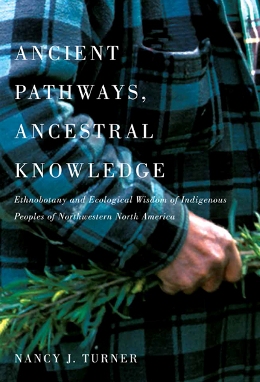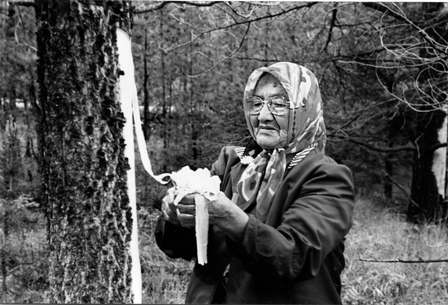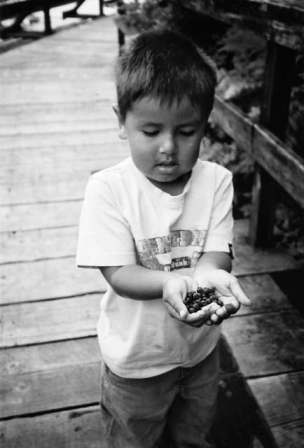The two-volume book, Ancient Pathways, Ancestral Knowledge: Ethnobotany and Ecological Wisdom of Indigenous Peoples of Northwestern North America, published by McGill-Queens University Press, represents, for me, a culmination of many years of research and thought about the complex, long-term, ever-changing relationships among humans, plants, and environments here in northwestern North America. How did people acquire the rich knowledge about their environments, including plants, algae, and fungi, that I learned about? How did they pass on their knowledge, practices, and beliefs from generation to generation, from family to family, and from community to community? And, how did they adapt these practices to new and changing situations they encountered? Finally, in the face of these rapidly changing times, with technological, societal, and environmental change happening at a seemingly ever increasing pace, how can this precious knowledge be recognized, maintained, and perpetuated for the benefit of future generations? These are the big questions that have been building up for me with each new detail learned, each new insight, and each new recognition of significance and connection stemming from my participatory, collaborative research with First Nations plant experts. In this book I have attempted to address these questions.
My first teachings in ethnobotany – the study of the relationships between people and plants – were in 1968, as part of my Honours BSc research at the University of Victoria, when I went to learn about plants of the W̱SÁNEĆ (Saanich) Coast Salish Peoples of Vancouver Island under Christopher Paul, elder of the Tsartlip community. He gently shared not only the SENĆOŦEN (Saanich language) names for plants and the various ways he and his ancestors applied them as foods, materials, and medicines, but he also told related stories and started to open a window into the spiritual importance of plants and places. Chris Paul’s father was from Tsartlip (Brentwood Bay), but his mother was from the Cowichan Nation, and spoke a different, though related language, which Chris also spoke. Learning from Chris Paul, and from other elders of the day, along with linguist colleagues who helped me to record more accurately the names I was learning, opened a new world to me. I had begun a journey of learning, and of endless fascination and building understanding that, over four decades later, resulted in the creation of this book.
My research on plants and First Peoples of northwestern North America has taken me to some of Canada’s most spectacular places, and I have had the privilege of learning from some of the wisest and most knowledgeable elders of many different First Nations, both on the coast and in the interior. Sometimes insights have come from two or more people, from different language groups and different geographic regions making similar observations or sharing similar experiences. For example, on one occasion in 1996, Kwakwaka’wakw Clan Chief Adam Dick, Kwaxsistalla, recalled how he would go with his mother and grandmother to work in the tidal marsh root gardens, called t’əkilakw, at the estuary of the Kingcome River, to tend and harvest the edible roots there: springbank clover (t’əxwsús), Pacific silverweed (dləksəm), Nookta lupine (qw’anniy), and northern riceroot (xúkwkwem). The plots of roots were marked off and pegged, weeded, or “cleaned” in the springtime, and harvested in the fall, when the leaves had started to die down. Kwaxsistalla talked about how he was taught to remove the small sprout growing from the base of some of the riceroot bulbs and put it back into the ground: “Yes, well that was my job… to pick them off… it’s on the bottom, called the gagemp [meaning ‘grandfather’ in Kwak’wala]. Then they told me to throw it back in the [garden plot]…. It’s like a cup and that xúkwkwem sits in there… that was my job as a kid, when I was with the old people….”(Clan Chief Adam Dick, pers. comm. 1996). When I asked, “So, Adam, is that gagemp going to grow into a new plant?,” he explained, patiently, “Yes! That’s why we did it!” I was amazed to hear about this. This was not “gathering,” or even harvesting; it was tending, planting, cultivation.
That very same summer I was with my dear friend and teacher from the Secwepemc Neskonlith Nation at Salmon Arm, the late Dr. Mary Thomas. Up at her childhood root harvesting grounds above Chase, at Neskonlith meadows, Mary started telling my graduate students and me about how, long ago, her mother and grandmother oversaw her and her siblings, harvesting their own root vegetables, including chocolate lily (a relative of northern riceroot), and yellow avalanche lily, called sxwixw [locally written scwicw], whose large, white tapering bulbs were a staple root vegetable of the Secwepemc, Stl’atl’imc, and Nlaka’pamux and other Interior peoples. She recalled, “My mother used to break off the little part at the bottom of the bulb – we called it the “whiskers” – and put that back into the ground. When we took our baskets of roots down to the camp, she would carefully remove the ‘whiskers,’ make a little pile of them, and bring them back to the root grounds the next day to bury back in the dirt.”
These two accounts of re-planting growing parts of highly valued root vegetables – northern riceroot in the coastal estuarine root harvesting sites, and yellow glacier lily in the interior montane meadows – brought me to a realization of something that had been staring me in the face all along: Indigenous Peoples of northwestern North America have been long-time plant cultivators. These plants – like virtually all the species used for food, materials, and medicines by these peoples – were perennials, and they could be maintained and propagated in situ, in ways that were seldom recognized by European newcomers and colonial officials, who saw them only as “hunter-gatherers” – random harvesters of naturally existing resources. Today, we are learning not only about the estuarine root gardens, but about the role of controlled burning, clam gardens, berry gardens, culturally modified trees and groves, and a whole array of approaches and protocols that helped people not only sustain, but enhance the quality and productivity of the plant and animal resources on which they relied. This has been part of my learning story.
Much of my research in ethnobotany and ethnoecology has been funded over the years by the Federal Government’s Social Sciences and Humanities Research Council of Canada, starting in 1984, before I was affiliated with a university, with a SSHRC independent scholar’s research grant on Comparative Ethnobotany of Thompson and Lillooet Interior Salish: Plant Names, Folk Categories and Plant Utilization. I am deeply grateful to SSHRC for their support of this work, and to the Federation for the Humanities and Social Sciences | Fédération des sciences humaines Awards to Scholarly Publications Program for their help in funding this publication, and for all the other research and publications made possible through their granting program. I am also grateful to McGill-Queen’s University Press and all their wonderful staff for bringing this book to reality.
In this series, we highlight books that have received funding from The Awards to Scholarly Publications Program (ASPP). ASPP is a competitive funding program run by the Federation that assists with the publication of scholarly books in the humanities and social sciences. Since 1941, the ASPP has funded more than 6,000 works, contributing directly to the creation of a distinctly Canadian body of knowledge in the humanities and social sciences. Read more about the ASPP here.
Credits: Images property of McGill-Queens University Press.



